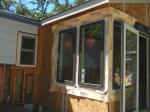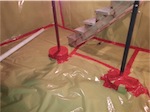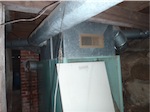Mold & Moisture Action Steps
These actions steps are from the “Help Yourself to a Healthy Home” guide from HUD.
- Use downspouts to direct rainwater away from the house. Make sure your gutters are working.
- Slope the dirt away from your house’s foundation. Make sure the dirt is lower six feet away from the house than it is next to it.
- Repair leaking roofs, walls, doors, or windows.
- Keep surfaces clean and dry – wipe up spills and overflows right away.
- Store clothes and towels clean and dry – do not let them stay wet in the laundry basket or washing machine.
- Don’t leave water in drip pans, basements, and air conditioners.
- Check the relative humidity in your home. You can buy a kit to do this at a home electronics or hardware store. Stop using your humidifier if the relative humidity is more than 50%.
- If the humidity is high, don’t keep a lot of houseplants.
- Wipe down shower walls with a squeegee or towel after bathing or showering.
- Cut down on steam in the bathroom while bathing or showering. Run a fan that is vented to the outside or open a window.
- Run a fan vented to the outside when cooking.
- If you have a dryer, make sure it is vented to the outside.
- Use a dehumidifier or air conditioner to dry out damp areas.
- If you use a humidifier, rinse it out with water every day. Every few days, follow the manufacturer’s directions for cleaning it or rinse it out with a mix of 1/2 cup chlorine bleach (Sometimes called sodium hypochlorite. “Clorox” is one brand.) and one gallon of water.
- When you use your air conditioner, use the “auto fan” setting.
- Throw away wet carpeting, cardboard boxes, insulation, or other things that have been very wet for more than two days.
- Increase airflow in problem areas – open closet doors and move furniture away from outside walls where mold is growing. Move your furniture around once in a while.
- Prevent moisture from collecting on windows by using storm windows. If you live in an apartment, talk to your landlord about putting on storm windows.
- Keep people with asthma or allergies away from damp areas of your home.
- Cover window wells if they leak.
- After cleaning up mold, using a high efficiency (HEPA) vacuum or air cleaner may help to get rid of mold spores in the air. You may be able to borrow a HEPA vacuum. Call your local or state health department to ask.
- If you find an area of mold greater than 15 square feet, it’s best to hire a professional to get rid of it. (You can find mold remediators trained and certified by the IICRC.)
- Clean up mold with a mix of laundry detergent or dishwashing soap and water OR chlorine bleach with soap and water. Do not mix chlorine bleach with any product that contains ammonia.
- If you think mold may be causing you or your family health problems, see a doctor. [HBS has a list of doctors (MDs and NDs) who specialize in environmental illnesses.]
Alex Stadtner is President of Healthy Building Science, a firm offering healthy building inspections and green building consulting services and based in the San Francisco Bay Area. This post originally appeared at their website and is re-printed here by permission of Healthy Building Science.








